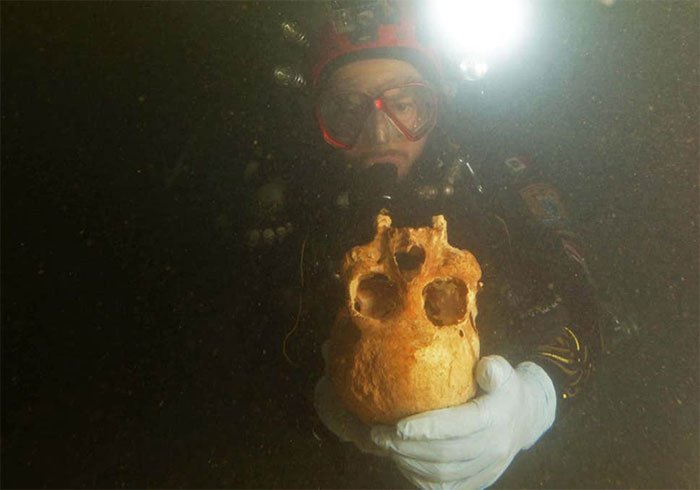10,000-year-old remains in an underwater cave
The remains belonged to a 30-year-old Paleoindian woman, helping to reveal new information about the first inhabitants to live in the Americas.
The remains, called Chan Hol 3 , were kept in good condition under Chan Hol cave , near the city of Tulum, on the Yucatan Peninsula, Independent reported today. The new finding shows that the first inhabitants of the Americas may include many groups of people from different geographical areas.

The woman's skull was found in an underwater cave.(Photo: Independent)
Paleoindian were the first to come to live in the Americas. Experts say they crossed Beringia, an ancient land bridge connecting Asia with North America, during the ice age more than 12,000 years ago, then migrated to Patagonia in South America.
"The new finding is important because it contradicts the traditional theory that the first American residents were just a group of Paleoindians, who moved very quickly from Beringia to Patagonia 12,000 years ago," said Silvia Gonzalez, professor at University of Liverpool John Moores University, a member of the research team, said.
"Our research shows that at least two different Paleoindian groups morphologically lived together in Mexico around 12,000-8,000 years ago, one in central Mexico and the other in the Yucatan Peninsula," he said. additional.
The team, led by Professor Wolfgang Stinnesbeck at Heidelberg University, determined that Chan Hol 3 lived at least 9,900 years ago, or even longer. According to structural analysis, this woman has a round head, large cheekbones, flat forehead. These features resemble the three skulls also found in the cave in Tulum, but unlike the long Paleoindian skull in other locations.
"The remains in Tulum point out, maybe the first people who came to the Americas were made up of groups from different geographic areas, or a small group of people who first came to live separately on the Yucatan Peninsula long enough to deliver. "Both cases show that the history of the early humans to America can be complex and begin thousands of years earlier than the traditional view," Gonzalez said.
- Ancient Roman skull in the river Thames
- The oldest modern human skull outside Africa
- Discovered the skull of the victim in the world's first murder
- The oldest remains reveal the Native American origin in the Americas
- Discover the largest underwater cave on the planet
- Detecting traces of people near Con Moong cave
- Mexico: Research the world's longest underwater cave
- Mexico studied 30 sets of ancient remains
- The mysterious 'Mayan world' inside the world's largest underground cave
- Revealing many prehistoric human remains in Southeast Asia's largest volcanic cave
- Wonderful world under water
- Discover rare fossils of the Ice Age bear and wolf-like predator
- Detecting the remains of 'hug each other without leaving' for 6,000 years
- The deepest cave map on Earth dates from the Cretaceous period
- The relics in the volcanic cave have bones of prehistoric people in Dak Nong
 Discovered an ancient centipede fossil 99 million years old
Discovered an ancient centipede fossil 99 million years old Discovered bat-like dinosaurs in China
Discovered bat-like dinosaurs in China Discovered a 200-year-old bronze cannon of the coast
Discovered a 200-year-old bronze cannon of the coast Discover 305 million-year-old spider fossils
Discover 305 million-year-old spider fossils